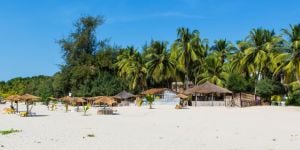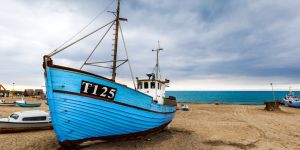
As Senegal's thriving capital city, Dakar is one of the most developed places to live in the country, offering many of the amenities that you might have come to expect back home. It is also one of the most expensive places to live and, in certain districts, incredibly crowded with many people vying for accommodation and subsequently pushing the rents up.
That being said, there is always a huge range of accommodation available to suit all budgets and styles if you know where to look. The key is choosing a few neighbourhoods that you would like to live in - according to location, amenities, proximity to your work etc. - and narrowing your search to those areas, especially if you decide to use an estate agent as some specialise in certain districts.
Important:
When searching for your new home, make sure you won't have to travel long hours to your workplace. Traffic in Dakar is terrible during rush hour, and short 5km journeys can easily take upwards of 40 minutes in a car, bus or taxi.
Neighbourhoods in Dakar
As a general rule of thumb, foreigners tend to live in accommodation in the centre and west of the peninsula, bordering the Atlantic. In particular: downtown Plateau (the commercial district), Fann, Point E, Mermoz, Sacre-Coeur, Ouakam, Mamelles, Almadies, Ngor and Virage. The eastern districts, such as HLM, Grand-Yoff, Dieuppeul and Parcelles-Assainies, the outer suburbs (e.g. Pikine and Guiedawaye) and those on the outskirts of Plateau (such as Medina and Colobane) tend to be lived in by locals (they are often more densely-populated, noisier and cheaper).
Choosing a neighbourhood tends to come down to your life and personal preferences. In Dakar, you should consider your place of work, schools, amenities (bars, restaurants, etc.) and the leisure activities you like to partake in (beaches, surfing, etc.). You may also look to live further from the centre to avoid the worst of the pollution and traffic problems that can affect the city. Besides, the more expensive areas are less affected by water shortages and power cuts.
Almadies, Ngor and Virage, for instance, are very popular with expatriates for being close to the ocean and offering a wide range of bars and restaurants that serve upmarket meals and alcohol. In these areas, you can find large villas and apartments with gardens and swimming pools, as well as many schools. Almadies, in particular, is one of the most expensive places to live in the city.
Point E, Fann and Mermoz, which are much closer to downtown and situated more in the centre-west of the peninsula, are more known for their peace and quietness. Here, there are broad streets with big houses with gardens, which are tucked away from the hustle and bustle. They tend to be popular with embassies, diplomats' families, government departments and well-to-do Senegalese families (and so have high prices to match).
Plateau is less attractive for expat families due to its density and traffic. Although you can find some houses with gardens, you are more likely to find high rise apartment buildings (the rest of Dakar's apartment blocks are relatively low-rise). However, the neighbourhood hosts many shops and commercial centres, as well as boasting some of the best restaurants, nightclubs and hotels in the city. If you work in the centre and don't mind the noise, then it is an excellent spot to live (on weekends the noise and traffic are considerably better too).
Amitié and Sacré-Coeur are two of Dakar's main residential areas. Both are known to be safe and quiet neighbourhoods, hosting shops, schools and other facilities.
Ouakam and Mamelles are located near the Monument de Renaissance, Africa's most significant monument, and the Atlantic ocean. Mamelles is very popular with young expats, as it is an area in the midst of development and offers affordable and well-positioned housing options. Many young, single expats (no children) choose to live here, while Ouakam is more local, offering a daily market and local eateries.
Yoff enjoys the longest stretch of sandy beach in the city, but is a very religious area and has its own set of rules as a result. It offers the cheapest accommodation next to the sea, but it is quite far from the rest of the city and has problems like electricity cuts and water shortages.
Rent prices in Dakar
Rent prices in Dakar are somewhat higher than those in other Senegalese cities. These, of course, vary according to the type of accommodation, size and comfort level.
If you are a young expat, looking to rent a bedroom in a co-shared house in Mamelles, for example, you can expect to pay 150,000 CFA per month with bills on top. An unfurnished three-bedroom apartment in a newly-built Mermoz apartment block will cost you around 800,000 CFA or in Ngor around 400,000 CFA. In downtown Plateau, you could spend over 1 million CFA for a two-bedroom apartment, while a four-bedroom villa in Almadies may be as much as 1.5 million - 2 million CFA per month.
Finding accommodation in Dakar
The easiest way to find accommodation in Dakar is to register with a real estate agency, which will help you find appropriate accommodation according to your criteria. You can also stroll around the different neighbourhoods to find vacant housing units and enquire within or browse housing listings on the internet and in local newspapers.
Dakarium - a Facebook group with almost 20,000 members - is the best place to find and sell almost anything in Dakar. Its group ‘Turfs and Cribs' is dedicated to finding accommodation in the city and you can browse posts or post your own.
Important:
Before signing your lease documents, make sure that the housing unit is equipped with air conditioning (not necessary between January-May) and a power supply backup.
Useful links:
Sene Logement (in French)
Planete-Senegal
Likibu
Dakarium
Jumia
Mamaison
We do our best to provide accurate and up to date information. However, if you have noticed any inaccuracies in this article, please let us know in the comments section below.








